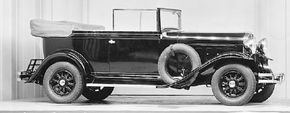Introduced in 1919, the Hudson-built Essex was a sales winner in its first two years, offering a lively four-cylinder engine and the first closed body types among popular-price mass-production cars. But when Essex adopted a less-reliable six in 1924, its image and popularity suffered accordingly.
Though this engine was enlarged and improved in 1930-31, Essex failed to win back its early reputation for ruggedness and durability. Hudson Motor Company might have failed with it except for a happy accident that saved the day.
Advertisement
Roy D. Chapin, one of Hudson's founders, was still active in the company during 1930-32, even though he was working for the Hoover Administration. When Hoover was voted out of office, Chapin immediately returned to Hudson and prepared to make some long-needed changes in the price-leading Essex line.
For 1932, he ordered the six enlarged from 160 to 193 cubic inches, which lifted horsepower from 58 to 70. This improved engine initially powered Pacemaker and Challenger models on a 113-inch wheelbase (unchanged since 1930).
But at midyear, Chapin dumped it into a new 106-inch-wheelbase series dubbed Terraplane. Said one memorable ad: "In the air, it's aeroplaning; on the water, it's hydroplaning; on the ground, hot diggety dog, that's Terraplaning!"
The Essex Terraplane turned Hudson around in 1932-33. It was fast (up to 80 mph), economical (up to 25 mpg), and cheap (as little as $425). Adding to its appeal was the 1933 option of a 94-bhp 243.9-cid straight eight.
Essex Terraplanes set numerous speed marks, including over 100 stock-car records. The public responded with enthusiasm -- so much so that Hudson dropped the Essex name after 1933 to make Terraplane a marque in its own right.
Advertisement
